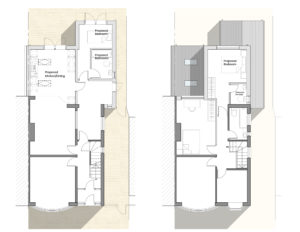Permitted Development: [FAQ] What Every Homeowner Should Know
So let’s say you are planning a new extension for your home office or perhaps with the coming of your second child you realised it’s time to build your dream two storey home.
Wouldn’t it be awesome to extend your property or build without full planning permission?
Well, this is what permitted development is all about.
I wrote this comprehensive guide to steer you through the process so that you are able to benefit from it. I’m writing this in a FAQ format, based on the questions I often get from my clients.
I’m going to provide you with all the details and give you the information you need to understand how permitted development works, what’s included in its rights, and which projects fall under this category.
What is permitted development?

Permitted development rights, as the name implies, allow you to extend your home without having to apply for permission.
Generally speaking, a lot of my clients tend to believe that every project requires some planning permission. Plus, I know for a fact that the lengthy and somewhat complicated process can stop many people from day one and thus giving up hope for their dream home.
Ok. Let me set it straight. If your project is really large you might need permission… Don’t be discouraged, there’s a lot you can do with Permitted Development rights.
In case you didn’t know, there are certain types of developments that can be done without permission, as long as you follow a few basic rules.
Below I will help you understand how you as a homeowner can exercise your rights to develop without disturbing your neighbours and the local authority.
Before I begin, here’s a disclaimer: if your home has been extended in the past you may not be able to use your rights.
With that being said, let’s jump right in!
Does everyone have PD rights?
The million dollar question.
Like above, if you’ve extended your home already you might not qualify for Permitted Development rights. Depending on where in the UK you are, you might face different restrictions.
Generally speaking, if you live in a:
- Conservation area
- National Park
- Listed building
- Areas of Outstanding Natural Beauty
- Broads and World Heritage Sites
You will need full planning permission and extra paperwork to move on with your project.
Let’s put it this way: Most houses do have permitted development rights. Exceptions will include flats and maisonettes.
As a homeowner you want to have the best information available before you make any major development decisions, am I right?
Here’s what I suggest: with a little help from a professional architect that understands your needs and regulations, you can be on your way to add a different dimension and value to your house. In fact, we at StudioTashkeel are able to transform your house to perfectly match your lifestyle.
Examples of Permitted Development
- A basic loft conversion
- Rear and side extensions
- Single and two storey extensions (up to a 6m projection)
- A porch (of less than 3m2)
- Solar panels
- Various other small projects, including garages and outbuildings can all be conducted under the permitted development rights.
Some considerations in detail regarding extensions:
- Extensions can take up to 50% of your plot, this is including the original building.
- Extensions need to be at least 7m from the boundary at the back
- No more than half the area of land around the original house* would be covered by additions or other buildings.
*original house it is meant that the property as it was first built or as it stood on July 1948.
Look, I get it.
The PD rules can be a bit tricky to understand and sometimes even be open to interpretation. So before you start planning, I can’t stress this enough, I highly recommend you to check with a professional architect or your local planning authority.
This will help you maximise the project’s probability of success.
Are there any restrictions?
Yes, there are a few things to keep in mind:
- Balconies, verandas, raised platforms are not considered to be permitted development, together with other conditions and size considerations.
- I should remind you that extensions also have a limit. Also, any modifications made by previous owners since 1948 are counted towards your PD allocation.
Are all extensions considered PD?
No. In this field size matters, unfortunately. The magnitude of your ideal extension and which part you plan to extend play a crucial role. Generally speaking, large extensions will most likely require permission.
In case you are wondering how much permitted development you are allowed…
To make it clear, understanding permitted development rights helps a great deal. Especially if you plan to make an extension just a bit over the PD limits.
Can Permitted Development Rights be removed?
Short answer: yes.
In detail: PD rights can be revoked by the council under something called ‘Article 4 Direction’ (this is usually to prevent changes in windows, removing boundary walls or further extensions for example). This could happen if your property is listed, belongs to a ‘Designated Land’ (national parks and such) or endangers the character of the local area.
If I think my project is under PD rights, can I start building right away?
Technically, yes. If your project fulfils the above mentioned criteria for PD rights.
Although like I said before, it’s better to double check your proposal and planning to see if everything falls under the permitted development requirements. Always refer to your planning consultant, architect or designer.
To be on the safe side, It is also worth to consider applying for a certificate of Lawful Development from your nearest local planning authority. This is essentially a document that proves your plans are under the PD rights and comply with all conditions.
You don’t need one – but think about it, with all that’s been said this certificate could bring you a lot of peace of mind. I totally recommend it. Especially when it comes to selling your house in the future, this can help you prove everything was done legally. You can read more about it here
Is Prior notification needed? Can neighbours object to my project?
Your local planning authority has to be notified of the details before any development takes place. PD rights depend on this. If neglected, it can hamper your chances of using available land.
Remember: work must not be commenced until the local planning authority has given you the green light.
Your local planning authority determines:
- Whether your proposal counts as an extension or rebuilding
- The type of materials used
- Whether there would be other implications such as environmental contamination, noise pollution etc…
Prior notification is also needed to inform neighbours and adjoining properties 21 days to bring up any objections on the proposed extension. This means that if your neighbours are against your proposal on the basis of threatening their property or the area, approval will not be granted and thus the proposed extensions will not be allowed.
To wrap it up, as you can see there is no easy way to talk about this without sounding too complicated. Householder rights for property extensions can fall into different categories and sub-divisions depending on planning.
I would like to remind you once again that if your project goes outside the scope of your PD rights, you’ll need to apply for planning permission. That’s why double-checking with your local authority or council saves you a lot of headaches before you begin.
We can make this process more simple and less painful for you. I wouldn’t want your project to be objected to by your neighbours. That would be a devastating turn of events, wouldn’t it?
However, it can happen.
During the development and design stages we can help you determine whether your project fulfils the PD criteria or not in a few simple steps. Contact us
